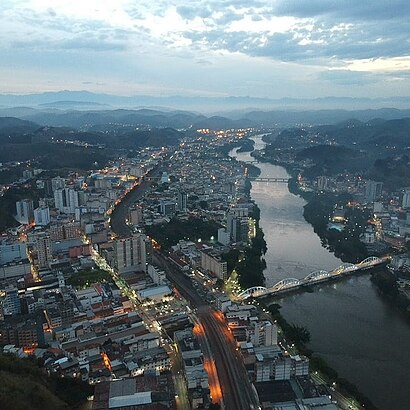Directions to Vila Coringa station (Regiao Administrativa III) with public transit
The following transit lines have routes that pass near Vila Coringa
How to get to Vila Coringa station by bus?
Click on the bus route to see step by step directions with maps, line arrival times and updated time schedules.
Bus stops near Vila Coringa in Regiao Administrativa III
- Rua Pinheiro, 228, 4 min walk,
- Rua Vereador Doutor Ernesto Da Silveira, 242, 4 min walk,
- Rua Major José Bento, 816, 5 min walk,
- Rua Major José Bento, 821, 5 min walk,
Bus lines to Vila Coringa station in Regiao Administrativa III
- CL014, Centro,
- CL121, Terminal Beira Rio,
- TR022-02, Santa Izabel ↺ Centro,
- TR022-01, Ari Parreiras ↺ Centro,
- CL010, Centro (via Lot. Sofia),
- CL011, Loteamento Sofia,
- P501, Volta Redonda,
- TR012-01, Centro,
- TR015-01, Amparo,
- TR016-01, Alto Vista Alegre,
- TR017-01, Vila Nova,
- TR017-02, Vila Nova (via Rua 9),
- TR130-01, Lot. Aiuruoca (via São Francisco),
- TR130-02, Centro → Lot. Aiuruoca,
- P502, Volta Redonda [via ETPC / C.M.],
What are the closest stations to Vila Coringa?
The closest stations to Vila Coringa are:
- Rua Pinheiro, 228 is 208 meters away, 4 min walk.
- Rua Vereador Doutor Ernesto Da Silveira, 242 is 220 meters away, 4 min walk.
- Rua Major José Bento, 816 is 321 meters away, 5 min walk.
- Rua Major José Bento, 821 is 330 meters away, 5 min walk.
Which bus line stops near Vila Coringa?
P501 (Vista Alegre (via Lot. Sofia))
What’s the nearest bus station to Vila Coringa in Regiao Administrativa III?
The nearest bus stations to Vila Coringa in Regiao Administrativa III are Rua Pinheiro, 228 and Rua Vereador Doutor Ernesto Da Silveira, 242. The closest one is a 4 min walk away.
What time is the first bus to Vila Coringa in Regiao Administrativa III?
The P501 is the first bus that goes to Vila Coringa in Regiao Administrativa III. It stops nearby at 4:10 AM.
What time is the last bus to Vila Coringa in Regiao Administrativa III?
The P501 is the last bus that goes to Vila Coringa in Regiao Administrativa III. It stops nearby at 12:53 AM.
See Vila Coringa, Regiao Administrativa III, on the map
Public Transit to Vila Coringa in Regiao Administrativa III
Wondering how to get to Vila Coringa in Regiao Administrativa III, Brazil? Moovit helps you find the best way to get to Vila Coringa with step-by-step directions from the nearest public transit station.
Moovit provides free maps and live directions to help you navigate through your city. View schedules, routes, timetables, and find out how long does it take to get to Vila Coringa in real time.
Looking for the nearest stop or station to Vila Coringa? Check out this list of stops closest to your destination: Rua Pinheiro; Rua Vereador Doutor Ernesto Da Silveira; Rua Major José Bento; Rua Major José Bento.
Bus: P501, CL014, CL121, TR022-02, TR022-01, CL010, CL011, TR012-01, P502.
Want to see if there’s another route that gets you there at an earlier time? Moovit helps you find alternative routes or times. Get directions from and directions to Vila Coringa easily from the Moovit App or Website.
We make riding to Vila Coringa easy, which is why over 1.5 million users, including users in Regiao Administrativa III, trust Moovit as the best app for public transit. You don’t need to download an individual bus app or train app, Moovit is your all-in-one transit app that helps you find the best bus time or train time available.
For information on prices of bus, costs and ride fares to Vila Coringa, please check the Moovit app.
Use the app to navigate to popular places including to the airport, hospital, stadium, grocery store, mall, coffee shop, school, college, and university.
Location: Regiao Administrativa III, Volta Redonda and Barra Mansa Region

Places Near Vila Coringa (Regiao Administrativa III)
Get around Regiao Administrativa III by public transit!
Traveling around Regiao Administrativa III has never been so easy. See step by step directions as you travel to any attraction, street or major public transit station. View bus and train schedules, arrival times, service alerts and detailed routes on a map, so you know exactly how to get to anywhere in Regiao Administrativa III.
When traveling to any destination around Regiao Administrativa III use Moovit's Live Directions with Get Off Notifications to know exactly where and how far to walk, how long to wait for your line, and how many stops are left. Moovit will alert you when it's time to get off — no need to constantly re-check whether yours is the next stop.
Wondering how to use public transit in Regiao Administrativa III or how to pay for public transit in Regiao Administrativa III? Moovit public transit app can help you navigate your way with public transit easily, and at minimum cost. It includes public transit fees, ticket prices, and costs. Looking for a map of Regiao Administrativa III public transit lines? Moovit public transit app shows all public transit maps in Regiao Administrativa III with all Bus and Train routes and stops on an interactive map.
Volta Redonda and Barra Mansa Region has 2 transit type(s), including: Bus and Train, operated by several transit agencies, including Colitur Transportes Rodoviários, Triecon Transportes, Cidade do Aço, Viação Elite, Princesinha do Vale | Itapetinga, Viação Pinheiral, Santa Edwiges | Viação Santa Luzia, Resendense, UFF - Universidade Federal Fluminense, Bem-Te-Vi Transportes, Transa Transporte Coletivo, JMS-Tur, Viação Falcão, UTIL - União Transporte Interestadual de Luxo and Viação Penedo
